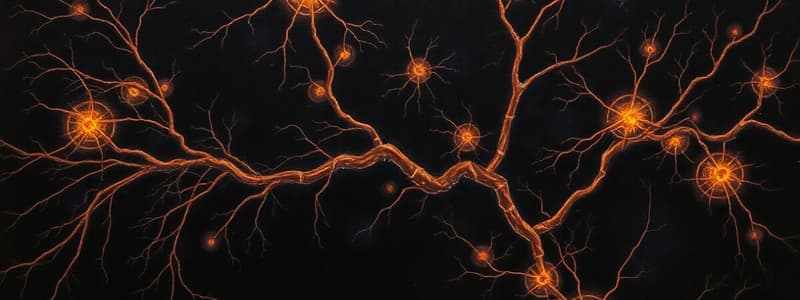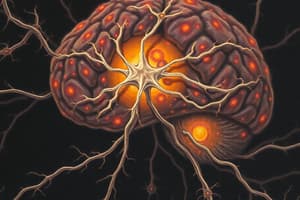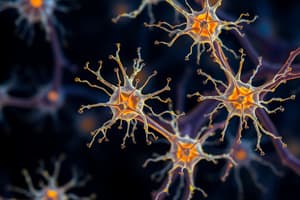Podcast
Questions and Answers
Which glial cell type is primarily responsible for removing dying cells resulting from neuron damage in the central nervous system (CNS)?
Which glial cell type is primarily responsible for removing dying cells resulting from neuron damage in the central nervous system (CNS)?
- Astrocytes
- Microglia (correct)
- Oligodendrocytes
- Schwann cells
What is the primary function of adult stem cells in the nervous system, relative to embryonic stem cells?
What is the primary function of adult stem cells in the nervous system, relative to embryonic stem cells?
- Repairing damaged tissue within the organ they reside. (correct)
- Developing into any specific cell type in the body.
- Producing myelin sheaths on axons in the peripheral nervous system.
- Generating diverse types of neurons across the body.
What is the functional result of the Nodes of Ranvier along the axon?
What is the functional result of the Nodes of Ranvier along the axon?
- Speeding up action potential down the axon. (correct)
- Insulating the axon to prevent signal loss.
- Synthesizing neurotransmitters for synaptic transmission.
- Decreasing the speed of action potential propagation.
How do selective serotonin reuptake inhibitors (SSRIs) enhance neurotransmission?
How do selective serotonin reuptake inhibitors (SSRIs) enhance neurotransmission?
Which of the following describes the function of interneurons?
Which of the following describes the function of interneurons?
What is the role of dendritic spines in synaptic transmission?
What is the role of dendritic spines in synaptic transmission?
During the resting state of a neuron, what contributes to maintaining the negative charge inside the cell?
During the resting state of a neuron, what contributes to maintaining the negative charge inside the cell?
How do terminal autoreceptors regulate neurotransmitter release?
How do terminal autoreceptors regulate neurotransmitter release?
What is the direct effect of chloride (Cl-) ion influx into a neuron?
What is the direct effect of chloride (Cl-) ion influx into a neuron?
Which of the following statements best describes the 'all-or-none' principle of action potentials?
Which of the following statements best describes the 'all-or-none' principle of action potentials?
Flashcards
Embryonic Stem Cells
Embryonic Stem Cells
Undifferentiated cells that can proliferate and become any specific cell type.
Neurons
Neurons
Nerve cells transmitting electrical signals throughout the body, forming the brain, spinal cord, and nerves.
Glial Cells
Glial Cells
Cells that support, insulate, protect, and metabolically support neurons.
Oligodendrocytes
Oligodendrocytes
Signup and view all the flashcards
Schwann Cells
Schwann Cells
Signup and view all the flashcards
Astrocytes
Astrocytes
Signup and view all the flashcards
Microglia
Microglia
Signup and view all the flashcards
Sensory Neurons
Sensory Neurons
Signup and view all the flashcards
Interneurons
Interneurons
Signup and view all the flashcards
Motor Neurons
Motor Neurons
Signup and view all the flashcards
Study Notes
- All cells in the body have identical material
- Embryonic stem cells form two primary types of cells for the nervous system
- Neurons transmit electrical signals throughout the body
- Glial cells insulate, protect, and metabolically support neurons
- Adult stem cells repair damaged tissue (not pluripotent) in the organ they reside
- Adult stem cells have limited therapeutic potential
- Adult stem cells are difficult to isolate and get large quantities for transplantation
- With age, the number of adult stem cells decrease
Glial Cells
- Oligodendrocytes produce myelin sheaths on axons in the central nervous system (CNS)
- Schwann cells produce myelin sheaths on axons in the peripheral nervous system (PNS)
- Astrocytes are large, star-shaped cells providing structural support by intertwining with neurons
- Astrocytes maintain the environment around neurons by taking up neuron chemicals
- Microglia are smaller than astrocytes
- Microglia remove dying cells (neuron damage)
- Microglia are the primary source of immune response in the CNS (i.e., inflammation reaction)
Neurons
- Neurons transmit information in the form of electrical signaling over long distances
- Sensory neurons
- Interneurons
- Motor neurons
- Sensory neurons convert physical stimuli into electrical signals that are sent to CNS via circuits of interneurons
- Sensory neurons transmit sensory information from sensory receptors to the CNS
- Sensory information helps with feeling
Interneurons
- Interneurons are nerve cells in the CNS forming complex neural circuits for sensorimotor integration
- Interneurons are responsible for decision making, cognition, memory, etc
Motor Neurons
- Motor neurons transmit electrical signals from the CNS to muscles
- Controls voluntary movement
Soma/Cell Body
- The soma/cell body is surrounded by extracellular fluid
- Synthesizes proteins (i.e., enzymes, receptors)
- Contains nucleus
- Contains pairs of chromosomes, which are long strands of DNA (deoxyribonucleic)
- Genes code for the production of a specific protein molecule and is a small portion of the chromosome
- Neurons are filled with cytoplasm
Dendrites
- Dendrites receive signals and pass it to the soma
- Has thousands of receptors on dendrites
- Dendritic spines increase the receiving surface area
- Dendrites and spines are modified in response to changes in synaptic transmission
- The most profound change is the number of spines in brain development
- Long-lasting changes in synaptic activity change the size, number, and shape of spines
- Mushroom-shaped spines are more efficient
- Dendritic atypicalities during brain growth indicate intellectual disability
- In people with schizophrenia, the atypical spines (less spines) are typical size spines with reduced spine density in the prefrontal cortex (PFC) along with intact intelligence, but cognitive and negative symptoms
- Negative symptoms: atypically absent, can't receive emotion and pleasure well
- Positive symptoms: atypical presents, hallucination
Axons
- Axons are filled with axoplasm
- Send action potential (axon hillock) to the axon terminal
- Axons bifurcate into axon collaterals
- Terminal buttons contain synaptic vesicles of neurotransmitters
- Axons are wrapped with myelin sheath
- Nodes of Ranvier increase speed of condution by speeding up action potential down the axon
- The thicker the myelin is, the quicker the action potential down the axon
- Multiple sclerosis (MS) is an autoimmune disease affecting oligodendrocytes causing myelin loss: confined to the brain, spinal cord, and optic nerves
Autoreceptors
- Neuronal receptors are specific for the same neurotransmitter released where neuronal receptors inhibit further release
- Terminal autoreceptors inhibit further transmitter release on the axon terminal
- Terminal autoreceptors are important when firing rapidly
- Somatodendritic autoreceptors slow cell firing causes less neurotransmitter to release
- Less action potential and neurotransmission
- Drugs can stimulate or block specific autoreceptors
Neurotransmission
- Transmit neurotransmitters in synaptic vesicles to the axon terminal
- An action potential must travel the length of the axon to cause synaptic vesicles to release neurotransmitters into the synapse
- Presynaptic neuron transmits to the postsynaptic neuron
- Pre and postsynaptic neurons don't touch each other, but a small gap inbetween is present
- Transmits from one direction, pre to post synaptic
- Convergence receives and integrates information from numerous cells
- Divergence is the integrated information being transmitted to other neurons
- Receptors are specialized to receive only certain types of neurotransmitters
Mechanisms of Neurotransmitter Inactivation
- Neurotransmitters are removed from the synapse through:
- Enzymatic breakdown where enzymes break down neurotransmitters
- Transporters:
- Reuptake transports out of the synapse by the presynaptic cell
- The synapse is transported by nearby glial cells, astrocytes
Psychoactive Drugs that Prevent Reuptake
- Some psychoactive drugs block transporters, enhancing neurotransmission
- Cocaine blocks transporters for dopamine (DA), serotonin (5-HT), & norepinephrine (NE)
- Selective Serotonin Reuptake Inhibitors (SSRIs) block 5-HT (serotonin) transporter
- Since 5-HT is reuptake 5-HT remains in the synaptic cleft for a longer time
Cell Membrane
- Made of a phospholipid layer (lipid-soluble where freely pass through)
- Includes proteins
- Receptors are the initial site of action of ligands
- Enzymes
- Transporters remove of neurotransmitters from the synaptic cleft
- Contain Ion channels
Ion channels
- Ion channels are relatively specific for particular ions
- Most channels are opened momentarily by specific stimuli to allow passage of ions through gated channels
- Channels open and briefly closes again
- Ligand-gated channels are regulated by a ligand binding to a receptor site associated with that channel
- Voltage-gated channels are regulated by voltage differences across the membrane
Resting State of Neurons
- Neuron is polarized at its resting state (-70mV) as the resting membrane potential
- The membrane has selective permeability
- Uneven ion distribution inside and outside the cell
- Positively charged ions are outside the cell, and negatively charged ions are inside the cell
- For potassium (K+) ions, concentration gradient and electro-static pressure are important for ion distribution
- K+ moves more freely through the membrane
- Some of K+ channels are not gated in resting potential
- Equilibrium potential for K+ balances the inward electrostatic pressure with the outward concentration gradient of K+
- Sodium (Na+) - K+ pump is an enzyme that helps to maintain the resting potential
- 3 Na+ ions are exchanged for 2 K+ maintaining a "-" charge inside the cell
Threshold for Firing
- Threshold for firing: -50mV membrane potential
- Voltage-gated Na+ channels open generally a rapid change from -70mV to -50mV
Local Potentials
- Localized change in voltage across the membrane following the opening of ligand-gated channels
- Sodium is more concentrated
- SODIUM causes Depolarization: the inside of the cell becomes more “+”, increasing the likelihood of an action potential (is excitatory) (cell would fire an action potential)
- Chloride causes Hyperpolarization: the inside of the cell becomes more “-”, reducing the likelihood of an action potential (is inhibitory) (reduce an action potential would fire)
- Hyperpolarization is negative and depolarization is positive
- Drugs/neurotransmitters cause EPSPs or IPSPs
Local Potentials: Relevance in Psychopharmacology
- Local potentials are generated on the dendrites
- Local potentials show summation (integration) (small things can add up to = larger change)
- Integration of EPSPs/IPSPs occurs in the axon hillock, and if the threshold is reached (-50mV) (resting potential = -70mV)
- When hyperpolarization & depolarization occur simultaneously, they cancel each other out
- Local potentials are graded
- As soon as the stimulus stops, the ion channels close
- EPSPs excitatory postsynaptic potentials and IPSPs are inhibitory postsynaptic potentials
Action Potential
- Upon integration, membrane potential is changed from resting to the threshold for firing
- Concentration gradient & electrostatic pressure, move large numbers of Na+ ions into the cell
- -50mV to +40mV: rising phase of action potential
- Absolute refractory period is the short time after an action potential when Na+ channels close & remain closed
- When resting levels are reached, Na+ channels are ready to open
- During the rising phase, voltage-gated K+ channels open & remain open
- Relative refractory period is a short hyperpolarizing phase after an action potential, where an intense excitatory stimulus is needed for an action potential
- All-or-none: reaching the threshold will generate an action potential, however more EPSPs will not make it larger
Neurotransmitter Receptors
- Transmit a signal from the presynaptic --> postsynaptic cell
- Neurotransmitter physically disengages after binding to the receptor & activating it
- Almost all neurotransmitters have receptor subtypes
- Most receptors fall into 2 broad categories: ionotropic receptors or metabotropic receptors
lonotropic Receptors
- lonotropic receptor: fast-acting
- Comprised of several subunits & an ion channel regulated by neurotransmitters binding to specific sites of the receptor
- In resting state: receptor channel is closed
- When neurotransmitter binds to the receptor & activates it, the channel immediately opens & ions flow across the membrane
- When neurotransmitter dissociates from the receptor, the channel quickly closes
- Also called ligand-gated channel receptors
- Some ionotropic receptor channels allow for sodium (Na+) ions to flow into the cell causing depolarization, excitatory response
lonotropic Receptor Channels Continued
- Some ionotropic receptor channels allow for calcium (Ca+) & sodium (Na+)
- Calcium can act as a second messenger
- First-messenger is the initial link in the chain of information transfer from one cell to another (i.e., neurotransmitters or drugs)
- Second-messenger is an intracellular molecule regulated by the first messenger (inside the cell)
- Chloride (Cl-) causes hyperpolarization, inhibitory response
Metabotropic Receptors
- Metabotropic receptors are slow-acting
- Composed of a single large protein in the cell membrane activating G proteins (or G protein-coupled receptor)
- All G proteins operate by 2 mechanisms:
- Stimulating/inhibiting the opening of ion channels in cell membrane
- Stimulating/inhibiting certain effector enzymes in cell membrane
- Increased synthesis/breakdown of a second messenger
- Biochemical/physiological changes in the postsynaptic cell
Allosteric modulation
- Allosteric sites are binding sites on a receptor that modulate the receptor's response to an agonist
- Allosteric modulators are compounds that bind to a receptor site distinct from the main agonist binding site
- Administered alone causes no effect
- They enhance (+ allosteric modulator) or reduce (- allosteric modulator) the effectiveness of an agonist
- Potential therapeutic use: "fine-tune" signaling by the neurotransmitter more subtly than an agonist/antagonist
Pharmacology of Synaptic Transmission
- Drugs enhance the action of a neurotransmitter by reducing its inactivation by blocking an enzyme or a transporter
- Blocking the enzyme involved in its breakdown such as MAO-inhibiting drugs that block MAO
- Blocking the transporter involved in its reuptake
- Cocaine blocks transporter for DA, NE & 5-HT
- SSRIs prevent the reuptake of 5-HT
- Drugs act on postsynaptic receptors for a specific neurotransmitter
- Agonists mimic the effects of the neurotransmitter on the receptor such as opioids - opioid receptors
- Antagonists inhibit the effect of the neurotransmitter on the receptor such as antagonists at the D2 receptor subtype of DA in people with schizophrenia
Studying That Suits You
Use AI to generate personalized quizzes and flashcards to suit your learning preferences.





